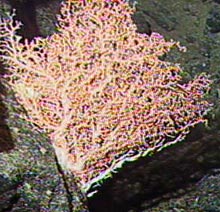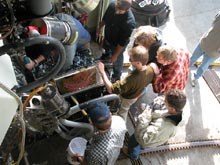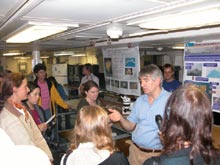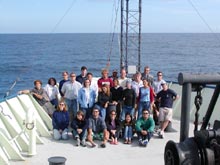
The 2004 Gulf of Alaska Seamount Expedition science party completes another successful cruise. Click image for larger view and more details.
Exploring Alaska's Seamounts:
Mission Summary
July 30 - August 23, 2004
Catalina Martinez
Expedition Coordinator
NOAA Office of Ocean Exploration
Jeff Pollack
Web Coordinator
NOAA Office of Ocean Exploration
The 2004 Gulf of Alaska Seamount Expedition was a great success. Thanks to good weather and a hard-working crew, we made 17 of 18 planned dives on five seamounts in the Kodiak-Bowie Chain – a potential record for the region! Many people on board had participated in the the previous Gulf of Alaska cruise in 2002, when we lost only one dive to bad weather. Clearly, Mother Nature has treated us well during our visits to this unique and potentially turbulent region.
Aboard the Woods Hole Oceanographic Institution's R/V Atlantis, the 2004 cruise consisted of a multidisciplinary scientific complement, divided into several discrete teams, each with numerous objectives. It took a great deal of coordination and compromise to carry out multiple objectives on each dive. This was not always easy, but the results were impressive.
Researchers collected a tremendous number and wide diversity of coral, sponge, and invertebrate samples, including a number of species that are new to science. They also collected rocks to determine the geologic histories of the seamounts. Full-coverage bathymetric maps were made of six different seamounts, including one seamount that had previously been documented only with satellite data.
The education products and outreach efforts were also remarkable. We brought the excitement of exploration and discovery to several very special groups of students and teachers through satellite phone calls. We also shared background information and day-to-day cruise activities with the general public through the NOAA Ocean Explorer Web site. Outreach efforts included the participation of an educator from an alternative school in Providence, RI and the development of lesson plans associated with the science conducted during the cruise. Media and educators toured the ship and spoke with scientists and crew when the cruise ended August 24 in Astoria, OR. See an article about the outreach and education ![]() associated with the Gulf of Alaska cruise.
associated with the Gulf of Alaska cruise.
Detailed summaries from each of the science teams follow this mission report. Read on for the specifics.
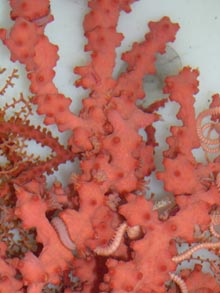
Basket stars (Asteronyx sp.), scale worms (Malmgrenniella sp.), and a scarlet king crab (Lithodes couesi) occupy this bubblegum coral. Click image for larger view and more details.
Deep-sea Corals as Habitat for Macroinvertebrates in the Gulf of Alaska
Dr. Thomas C. Shirley
University of Alaska, Fairbanks
Principal Investigator -- 2004 Gulf of Alaska Cruise
We found a diverse assemblage of invertebrates and fish in association with corals on the five Gulf of Alaska seamounts we explored. My research group participated in 8 of the 17 deep submergence vehicle (DSV) Alvin dives, with dives conducted on all seamounts. Samples were also collected for our research on all dives made by the other research projects. We acquired more than 300 separate specimen collections, containing representatives of at least 12 metazoan phyla on corals.
We used various collection techniques, including a multi-chambered slurp gun to vacuum animals from corals and nets to enclose animals on corals. We collected larger animals and entire corals by means of the DSV Alvin. The digital photography and video transects also provide valuable data of the spatial distribution of the species on the corals.
We discovered a complex community of organisms, ranging from microscopic to macroscopic, living on corals. Among the largest and most common organisms were the suspension-feeding chirostylid crab (Gastroptychus iaspus), the gorgonocephalid brittle stars (Asteronyx sp.), and a large hippolytid shrimp (Heptacarpus sp.). Large numbers of Gastroptychus iaspus were present only on corals and not on the surrounding sea floor. This was the only galatheid crab species found on corals; however, a few other kinds of crabs were also observed on corals.
Similarly, the unbranched basket star (Asteronyx sp.) was found only on corals and was almost always seen on different coral species (and individuals) than the chirostylid crabs, suggesting competitive interactions between the crab and the basket star. Both the chirostylid crab and the basket star were restricted to shallower depths, and neither was found deeper than 950 m. At deeper depths, however, other species of brittle stars replaced the basket stars on the corals, often in dense concentrations. We collected 656 brittle stars on one small coral (<1200 cm2). We think these high densities must impose energetic constraints on corals by impairing feeding or affecting other physiological processes.
Dense assemblages of organisms may have been present on corals for many reasons. One simple advantage that corals offer their tenants is an elevated feeding station, allowing suspension feeders access to higher current flow and more efficient feeding. Many of the invertebrates found on the corals -- such as brittle stars, crinoids, galatheid crabs, and anemones -- are suspension feeders. Current flow rates increase geometrically with height above the benthos (bottom-dwelling flora and fauna), because drag decreases with height above the benthic boundary layer. Taller corals would provide access to faster current flows than shorter corals. Corals are also suspension feeders, so if the corals are thriving, the assemblage of suspension feeders living on the corals should also thrive.
Another advantage is that corals offer increased structural complexity, perhaps providing refuge from predators. Many of the smaller organisms associated with the corals, such as small crustaceans, are not suspension feeders, and they may be occupying corals only for the habitat. Corals provide them with shelter and get them off the bottom and away from their predators, some of which are restricted to the bottom. Some animals associated with corals are undoubtedly using their hosts for protection in yet another manner. All corals are equipped with organelles containing stinging structures, or nematocysts, used by the corals for feeding and protection. The stinging cells that protect the coral would also afford protection for the animals living on the corals.
Corals also serve as prey or sources of nutrition for other animals found on them. Some organisms, such as the sea spiders (pycnogonids) feed on the fluids of the coral without causing mortality to the coral colony. We observed pycnogonids feeding on corals in situ. In contrast, sea stars consume large portions of a colony in one prolonged feeding session. Several sea stars were observed actively feeding on corals. Malmgrenniella sp., scale worms or polychaetes, were found in abundance on all bubblegum corals and may derive nutrition from coral secretions or from microorganisms associated with it.
Undoubtedly, many of the animals we collected represent undescribed species or significant range extensions; all await confirmation of identification in post-cruise processing. I am certain that we collected additional specimens of both sexes of an undescribed galatheid crab that we previously collected from Alaskan seamounts in 2002. Many of the smaller macrofauna (e.g., pycnogonids and munnid isopods) and the harpacticoid copepods probably represent species unknown to science. Perhaps most importantly, we have the data to determine the habitat specificity for most of the more common species and to examine other ecological relationships. We will be able to determine if some animals select certain species or sizes of corals and whether the corals represent essential habitat for some animal species.
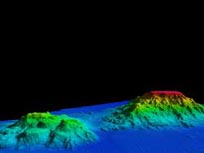
This 3-D perspective, generated from our bathymetric mapping of Ely (left) and Giacomini (right) seamounts, shows the rugged flanks and flat tops typical of Gulf of Alaska seamounts. Click image for larger view and more details.
Geology of the Gulf of Alaska Seamounts
Randy Keller
Oregon State University
Our goal was to gain an understanding of the geologic histories of the five previously unexplored seamounts in the Gulf of Alaska. To achieve this we created a full-coverage swath bathymetry map of each seamount and its surroundings, and we collected rock samples at all possible depths.
We will use these maps and samples to determine the ages of the seamounts, the type and volume of volcanic eruptions that created the seamounts, the size and style of subsequent modifications (such as slope failures and rock slides), and the interaction of the seamounts with features on the surrounding sea floor (such as sea channels and sediment fans).
Even our preliminary maps show evidence of large-scale collapse of the flanks of some of these seamounts, which has profound affects on the shapes of the seamounts and the morphology of the surrounding sea floor.
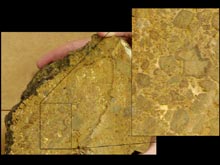
This is a hyaloclastite -- a highly fragmented volcanic rock common on the upper slopes of seamounts in the Gulf of Alaska. Click image for larger view and more details.
In the lower parts of each of the seamounts, we found spectacular exposures of basaltic lava flows, often in the form of walls or ridges of pillow basalts. On the upper portions, we also found hyaloclastites -- a glassy, highly-fragmented volcanic rock. The lower confining pressures of shallower water may explain part of this difference in rock types. It is also possible that lavas erupted during the later stages of volcanic evolution of the seamounts and (thus found near the top) contain more volcanic gases.
We recovered at least one good rock sample from 16 of the 17 dives, so we have an exceptional collection of rocks suitable for our laboratory analyses. These analyses will include using isotopic dating to determine the timing of the volcanic eruptions as well as studying the chemical composition of the lavas to look for relationships between lavas within each seamount and between seamounts. We will examine microscopic mineral textures in the rocks in order to determine lava flow cooling and crystallization histories. We will also search for microscopic indications of microbial activity within the rocks and conduct laboratory analysis of the rocks for microbial DNA.
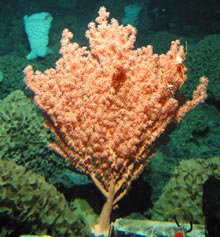
We found a number of coral species in the family Paragorgiidae. They are often referred to as "bubblegum corals," because of their candy-pink hue. Click image for larger view and more details.
Deep-sea Coral Distribution on the Northern Seamount Chain
Amy R. Baco-Taylor, PhD
Woods Hole Oceanographic Institution
The dominant hard-bottom fauna of seamounts are deep-sea corals, primarily gorgonian octocorals. The goal of our study was to document the corals present on these seamounts and to compare species composition, abundance, and diversity between seamounts. We were also interested in how these factors change with depth on the seamounts.
To address these questions, we conducted both vertical and horizontal transects on each seamount. Horizontal transects were conducted at each of three depths, 700 m, 1,700 m, and 2,700 m. We collected voucher specimens of as many coral species as possible on each seamount as well as other dominant invertebrates --including sponges and echinoderms -- to aid in identifications of corals and other invertebrates observed on the transects. Also, we collected Conductivity-Temperature-Depth (CTD) data on CTD casts and on the submersible; we will compare these data to the coral distribution data.
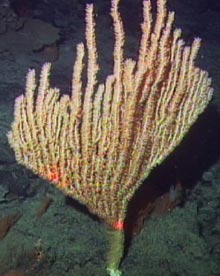
Bamboo corals were among the dominant groups. They are in the family Isididae. Click image for larger view.
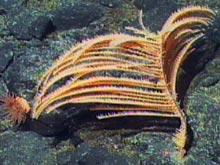
Antipatharians were another very diverse group. These corals are often called "black corals," referring to their dark, black skeletons. Click image for larger view and more details.
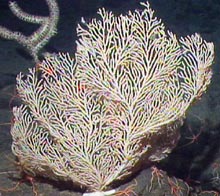
Primnoids are a very diverse group of corals that range from highly branched forms, like the one shown here, to forms that branch only near the base. Primnoids were also very common on these seamounts and were represented by several genera. Click image for larger view.
We successfully completed 17 or the 18 planned dives, including 23 of the 24 planned horizontal transects. We collected over 140 coral specimens and preserved them for taxonomic identification by the Smithsonian Institution as well as for future genetic and/or reproductive studies. Overall, Primnoids, Paragorgids, Isidids, and Antipatharians were the most abundant groups. Only one species of scleractinian was observed and collected.
Corals were most abundant on the shallowest depths of each seamount, with Paragorgids and Isidids being the dominant families. Along the 2,700 m transects, Primnoids were the dominant family. The 1,700 m depth zone had the fewest corals and low diversity. Antipatharians and Primnoids were the most commonly observed families at this depth. Many of the species collected appear to overlap with those collected on the 2002 Gulf of Alaska cruise on the central seamount chain. Those seamounts, however, were not sampled comprehensively for corals, so a complete comparison can not be made.
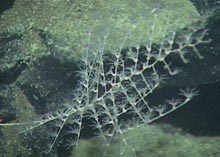
The delicate coral here is in the family Chrysogorgiidae. This was the only specimen we observed on our 2002 and 2004 cruises in the Gulf of Alaska. Click image for larger view.
There are likely to be at least a few species of coral that are new to science among our collections. We collected one specimen of Chrysogorgid that may be new. This is the only collection of this family from either the 2002 or 2004 cruise. We also collected several species of Paragorgiids, at least one or two of which may be new species. Finally, we extended the northern edge of the range for the family Coralliidae from Patton Seamount (collected on the 2002 cruise) to Pratt Seamount. Further counts of new species and range extensions will likely arise with further taxonomic identifications of the specimens.
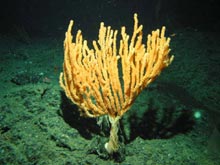
A live bamboo coral in 800 m of water on Pratt Seamount. The bright orange polyps obscure the bony skeleton of the bamboo coral. Click image for larger view and more details.
Bamboo Coral and Glass Sponge Habitats
Peter Etnoyer
Aquanautix
Sponsored by Marine Conservation Biology Institute
George P. Schmahl
Sanctuary Manager
Flower Garden Banks National Marine Sanctuary
Our objectives for this cruise included the collection, preservation, and documentation of bamboo corals (family Isididae) in the Northeast Pacific, and the documentation of bamboo coral-associated fauna. Further objectives included in-situ photo and video documentation of bamboo coral communities, as well as the collection and preservation of deep-sea sponges.
We found representatives of the bamboo coral family Isididae on every seamount, throughout the range of depths of our exploration. The shallowest collection came from 720 m and the deepest collection from 2,778 m. Samples were taken from all four genera, including Isidella, Keratoisis, Lepidisis, and Acanella. Candelabra-shaped Isidella colonies were abundant at some sites. These branch dichotomously (twice) and trichotomously (thrice) at the node. They are rivaled in size and beauty only by the bubblegum corals.
We turned out the lights on two separate occasions to witness a faint glow emanating from the lightly disturbed branches of the largest bamboo corals. These Isidella colonies are bioluminescent, just like their cousins in the genus Lepidisis and the genus Keratoisis. We recorded large monotypic stands of Isidella sp., with ubiquitous colonies spaced broadly over an entire 1.5 km transect.
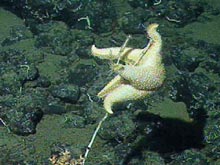
A sea star climbs a denuded bamboo coral skeleton and feeds on the unprotected polyps. The gorgonaceous nodes are more obvious in this photo. This coral will probably not survive. Click image for larger view and more details.
Galatheid crabs sometimes crowded themselves onto a broad single colony, filter feeding with their claws outstretched, five and six abreast. At other sites, we would find no crabs on the bamboo corals. The crabs were more abundant on the sea floor.
We documented several cases of “antagonistic interactions” from sea stars. Predators such as the Crown-of-Thorns starfish are known to feed upon shallow tropical coral reefs. These deep-water sea stars climb the branches of small bamboo corals to feast on the non-retractile fleshy polyps. These types of polyps are easy prey. Acting on a weblog from the East Coast’s Mountain in the Sea Expedition, we flushed one sea star’s gut cavity to discover sponges, diatoms, and sclerites from bamboo corals and bubblegum corals. At some sites, specimens of dead bamboo colonies occurred in abundance, suggesting these species are highly susceptible to predation. We hope to pursue further research on these trophic links, painting the deep-sea portrait of a bamboo coral ecosystem.
Another objective of this cruise was to provide an initial characterization of the sponge fauna associated with the seamounts of the Gulf of Alaska. The sponge community of this area is not well known, and there are very few records or descriptions of sponges in the scientific literature. During the course of 17 dives, we collected 34 sponge specimens. Due to the delicate nature of deep-water sponges, only a few were collected in whole condition. The collection of adequate tissue samples and underwater imagery, however, should allow us to identify many of the species. Several of the species were collected more than once. Initial analysis indicates at least 21 different species are included in the collection.
Our observations during the dives documented that sponges are an obvious and important component of the benthic community of the Gulf of Alaska seamounts. The sites with the most prolific sponge communities were in the shallower depth ranges (700-1,000 m). Two sites, the 700 m regions of Dickens and Welker seamounts, exhibited particularly abundant sponge faunas. It was also obvious that sponges provide important habitat for a variety of associated animals, including brittle stars, shrimp, crabs, and crinoids. We need much more research to accurately characterize the ecological role of sponges in these deep-water habitats.
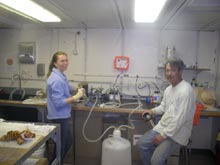
Naomi Ward and bosun Patrick Hennessy filter seawater to trap bacterial cells for later identification. Click image for larger view.
Genetic Exploration of Deep-sea Microbes
Naomi Ward
Assistant Investigator
The Institute for Genomic Research
Our objectives for this cruise were to collect and characterize bacterial communities associated with deep-sea animals on the seamounts. Coral collection was our primary focus: we wanted to build on data gleaned from the small number of coral samples gathered during the 2002 Gulf of Alaska Seamount Expedition.
The 2002 data suggested the presence of bacteria associated with the polyps and mucus of bamboo and black corals. Corals of different species appeared to have characteristic and distinct bacterial populations; and corals of the same species from different seamounts also differed in their associated bacterial flora. In addition, sampling of the water around coral colonies suggested that while there was some overlap in bacterial populations (due to transient presence of water organisms on the corals), other groups of bacteria found on the corals were not found in the water and thus may be coral-specific.
The collection and analysis of multiple individuals of each coral species was a high priority for the 2004 cruise. We were fortunate to be able to collect samples of 62 coral specimens (22 bamboo, 15 paragorgid, 19 primnoid, 7 black, 23 other), 13 sponge specimens, and 36 water samples. Supplementary to the collection of corals was the collection of commensals living on coral for the examination of the bacterial communities associated with these inhabitants. We collected seven commensals (three polychaete worms and four sea stars) from various corals. Finally, we sampled other macrofauna, such as crabs and sponges, for bacterial community studies.
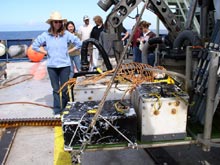
Naomi Ward prepares to collect mucus and polyp samples from this big bamboo specimen carried on DSV Alvin’s basket. Click image for larger view and more details.
The bulk of sample processing (DNA extraction, PCR, cloning, and sequencing) and analysis will be conducted post-cruise at TIGR. At that time, we will determine the composition of the bacterial communities. One of our future goals is to select a small number of samples for construction of genomic DNA libraries and random shotgun sequencing. Information derived from this approach will provide a first glimpse of the metabolic activities of these bacterial populations, allowing us to formulate hypotheses about how the bacteria interact with each other and with their animal host. There is a wide range of possible host-bacterium relationships, from parasitism to mutualism, about which we still have much to learn.
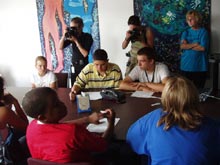
Students at the UCAP school in Providence, RI talk by satellite phone with NOAA scientist and former UCAP employee Catalina Martinez, who is in the DSV Alvin more than 8,000 ft deep in the Gulf of Alaska. Click image for larger view and more details.
Chief scientist Tom Shirley discusses the results of the cruise with reporters and educators August 24 in the main science lab on the R/V Atlantis. The Atlantis was in port in Astoria, OR. Click image for larger view and more details.
Gulf of Alaska Seamount Expedition: Outreach and Education Summary
Catalina Martinez
Ocean Explorer Expedition Coordinator
"I hope the kids will see how fascinating the world is and what they can do when they are educated . . . The more they see beyond the boundaries of their neighborhoods, the farther they can go --and they'll see possibilities instead of limitations."
-- Rob DeBlois, UCAP School Director
Ocean Explorer provides opportunities for teachers, students, and the general public to participate in ocean exploration activities. These experiences are made possible through various initiatives associated with all major cruises and projects.
During the Gulf of Alaska Seamount cruise, we created special opportunities for at-risk students from two very different communities (Providence, RI and Indianapolis, IN). We also conducted outreach efforts and developed education products associated with this cruise. Our results include the following:
- We developed three new lesson plans for Grades 5-12 that can be accessed via the NOAA Ocean Explorer Web site.
- A Professional Development Institute (PDI) for teachers took place August 14 at the Alaska SeaLife Center. The educators learned first-hand how to conduct lessons related to Gulf of Alaska expeditions. They also interacted via satellite phone call with scientists and educators aboard the R/V Atlantis and the DSV Alvin during the cruise.
- Five satellite phone calls were made from sea to students and teachers at various institutions, including two alternative schools for at-risk students (UCAP in Providence, RI and Wayne Enrichment Center in Indianapolis, IN), and summer interns at The Institute for Genomic Research (TIGR). We patched three of the calls down to the scientists and crew working at depth in the DSV Alvin.
- We provided UCAP science teacher Carey DeLauder the opportunity to participate on the cruise as a member of the science party.
- We provided at-sea opportunities for a Marine Advanced Technology Education Center intern, a Dean John A. Knauss Sea Grant Fellow, and nine other students, including two graduate students from University of Alaska, Fairbanks, three from Oregon State University, two undergraduates, and two recently graduated baccalaureates.
- Of the 31 seats filled by scientists in the Alvin submersible during this 17-dive cruise, 14 were filled by new divers, mostly graduate students, undergraduates, and recent graduates.
- We developed signature coverage on NOAA’s Ocean Explorer Web site and multimedia products for the OceanAGE site.
- A "media availability" was held August 24 in Astoria, OR so that media and educators could tour the R/V Atlantis and DSV Alvin and interact with the scientists who collaborated on this cruise.
Sign up for the Ocean Explorer E-mail Update List.

























